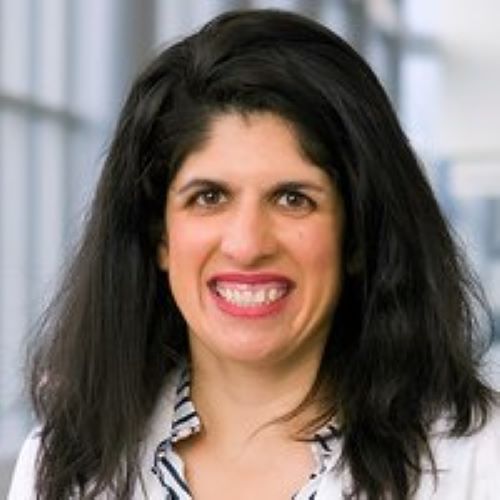Physical Medicine & Rehabilitation
Assistant Professor of PM&R
O'Donnell Clinical Neuroscience Scholar
Department of Physical Medicine and Rehabilitation
shanti.pinto@utsouthwestern.edu (Preferred method of Contact)
214-648-2240

About the Specialty
Physical Medicine and Rehabilitation (PM&R), also called Physiatrist, is a branch of medicine that is unique, because the goal of care is to improve a patient’s quality of life and ability to function. Physiatrists are a cross between orthopedists, neurologists, psychiatrists, and internists, specializing in disorders of the brain, nerves, muscles, and joints.
PM&R doctors can treat a wide variety of patients in a wide variety of settings, and typically act as the leader of a team of health care providers who work together to help patients with disabilities, chronic pain, injuries, or neurologic disease. PM&R is a highly procedural field as well as a very interactive one – it is a good choice for people who want long-term patient relationships, enjoy working in a team with other health care providers such as physical therapists, and for people who want to be hands-on or procedural without being surgeons.
Answers to Common Questions
- Attributes of a Competitive Student
What factors typically make a student competitive for this specialty?
- Genuine interest in the field
- Leadership ability, personable/friendly
- Step 1 >220 typically, although if less can still potentially match if willing to apply broadly
- Quartile 1-3, although 4th quartile can still potentially match if willing to apply broadly
- Volunteer activities that demonstrate a caring nature and that you are a “people-person.”
- Research in PM&R or a related-field
- Personal statement that reflects that you truly understand PM&R and what makes our field different and special compared to other fields.
- Make sure you are able to explain what is physiatry and why you want to go into the field. Experience in both the clinical rotations but also some extracurricular activities within PM&R or working with people with disabilities helps to demonstrate your interest. Even if you "found PM&R late," you should be able to explain in your personal statement and to your interviewers how your prior experiences shaped your interest in the field and why you will be a good physiatrist.
- Research
How important is research experience in your specialty? If important, does it need to be in the specialty itself?
Research is growing in importance, as PM&R becomes more popular and competitive. It is not absolutely necessary to have research in the field of PM&R or related areas (ortho/neuro/rheum), but it does help.
- Shadowing
How can students identify opportunities for shadowing?
Contact the PM&R Medical Student Coordinator, Godley Johnson via email. godley.johnson@utsouthwestern.edu Please specify what days and times you have available and also if there are any particular areas or subspecialties within PM&R that you are interested in shadowing.
Additional Information
- PM&R Student Interest Group
- Sports Medicine Student Interest Group
- What is Physiatry?
- AAPM&R Medical Student Resources
- Video: What is PM&R?
- Video: What Makes Physiatry Unique?
- Video: Why I Chose Physiatry
- Electives
What electives would you recommend to a student who is interested in pursuing your specialty?
PMED 2001 – Exploration of PM&R, PMED 1901 – Sub-internship in PM&R, PMED 2002 – Advanced PM&R Neurorehabilitation, PMED 2003 – Advanced PM&R MSK and Spine Medicine, PMED 2004 – Advanced PM&R Pediatric Rehabilitation Medicine. Also, electives in neurology, orthopedic surgery, rheumatology, psychiatry, and radiology are helpful.
Based on your experience, what tips do you have for students to shine on your electives?
Show interest, come prepared, read in advance, don’t do the bare minimum, ask questions, attend lectures, be prepared on rounds and in clinic.
- Away Rotations
Away rotations are not necessary but are increasingly popular. They can hurt you as much as help you, however, so consider carefully whether you want to do one. It is mandatory to complete PMED1901 prior to doing any away rotation in PM&R.
If your specialty recommends doing away rotations, how many “aways” do you recommend?
0-1.
If away rotations are necessary, when should they apply and when should they be completed?
If you are planning to do an away rotation, it should be completed by the end of October of MS4 year.
- Interview Timing
Which month do you recommend taking off to interview?
You will have to interview for both PM&R and a PGY-1 year, therefore we recommend taking two full months off between November and January, and then having a light rotation for the other month in this block.
- Letters of Recommendation
How many letters of recommendation are needed to apply to your specialty?
Three letters of recommendation are required, most people submit four.
Does your specialty recommend that all letters of recommendation be written by members of your specialty?
Only one letter has to be from PM&R, one should be from Internal Medicine. The others could be from any faculty who knows you well and can write a very personal letter.
If letters can come from other disciplines, do you have a recommendation as to which disciplines are more highly valued?
IM, neurology, orthopedics, psychiatry
Does the academic rank of the letter writer matter?
To some degree, but it matters more that they know you well and can write a detailed letter with specifics about you as a person and a future physician.
Does your specialty require a letter from the chairman?
No.
